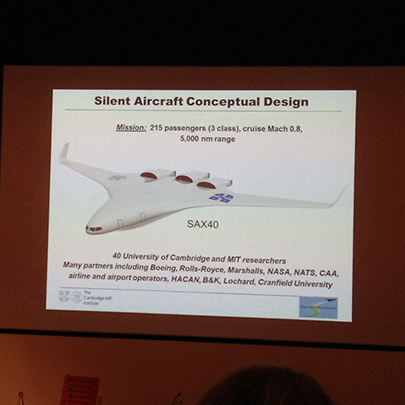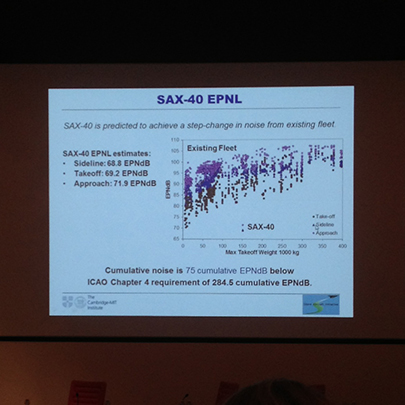Towards the Silent Aircraft
Presented by Professor Dame Ann Dowling
The IMechEng, London, October 2014
Professor Dame Ann Dowling presented the work of her team of 40 University of Cambridge and MIT researchers, the focus of which was to produce various methods of reducing aircraft jet noise. She began by discussing the historical method of reducing jet noise by increasing jet area, before discussing the more up-to-date and innovative methods developed by her team.
Liners
Liners are currently used in aircraft jets to reduce rearward propagating noise caused by the fan pushing air throughout the whole engine. The new design developed by the team incorporates these in greater quantity, these being inserted behind the fan on the inner surface area of the entire engine.
3D Blade Design
The 3D blade design is a new innovation that reduces fan tones. One of the main sources of jet noise is the rotor wakes that scatter from the leading edge of the Outlet Guide Vanes (OGV), and the suggested sweep profile of the 3D blade design promotes cancellation of this. The fan blades are optimised to retain the aircraft performance within engine mechanical and structural constraints, and obtain a 7dB reduction in tone noise.
Chevrons
As a further innovation for noise reduction, chevrons have been introduced as a subtle method, however a current lack in modelling techniques means that chevron designs require a lot of empirical testing for optimisation. Experimental data was presented to show the benefits of chevrons in noise reduction.
Jet noise modelling
The team's improved modelling technique enhances ability to optimise chevron design. Professor Dowling presented the techniques, which are able to give quick predictions to aid design optimisation. Further benefits to the modelling technique are an enhanced understanding of the noise source mechanisms, their location, and how chevrons and microjets alter them.
Blended wing body design
In this design, the jets are mounted on top of the body so that the sound waves propagate upwards instead of downwards, therefore reducing exposure to civilisation below.
Other features of the design are the ultra high bypass ratio engines, an advanced airframe design which reduces drag and shields the extensive noise absorbing liners around the jets, a flared undercarriage, deployable drooped wing leading edge and variable area exhaust nozzle. As the slide shows, it was highlighted which of these features reduce fuel burn.
Conclusion
The presentation was concluded by outlining nearer-term methods for jet noise reduction such as careful design optimisation and effective modelling to capture the effects of noise reduction techniques. Those for longer-term implementation were also specified, including a novel efficient airframe design without flaps or slats and new aircraft configuration with engines placed above which provide not only noise reduction but also reduced fuel burn.



















